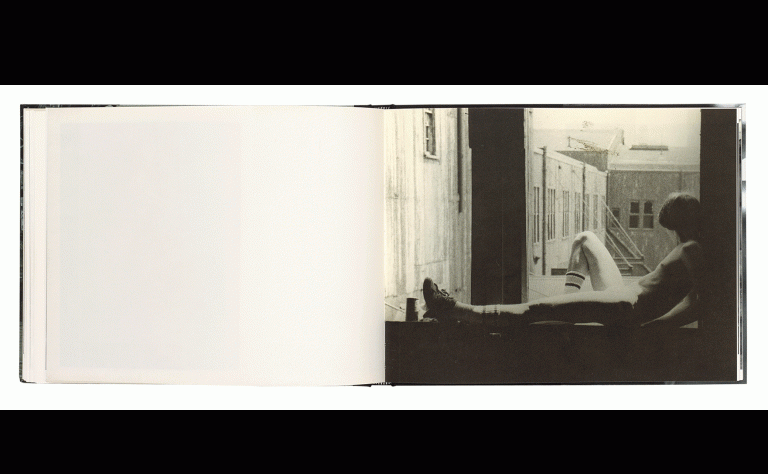Looking Through Two Books of Alvin Baltrop’s with My Computer to Help by Samuel R. Delany
My firsthand knowledge of the docks and the sexual action that went on there under the highway and among the docks was about over when Alvin Baltrop’s photographs begin. One book, in which over 170 of his images are entombed, begins with Douglas Crimp’s observation, “In December 1973, a highway repair truck, laden with asphalt, crashed through the elevated West Side highway between Little West 12th St. and Gansevoort St., closing forever the section of the highway south of the collapse.” By that time, I had abandoned New York – and the kind of activity I wrote about both in The Motion of Light in Water, which took in many trips from east to west and hamburgers and coffee at the Silver Dollar 24-hour breakfast place on Christopher St., of which my meetings with Bill Stribling and Joe Soley were the most memorable, and a very uncharacteristic account in my memoir, The Real Joe Dicostanzo, which occurred shortly after the breakup of my music group Heavenly Breakfast and the murder of Martin Luther King on April 4th, 1968, by James Earl Ray. I doubt I ever stepped foot on or in Pier 52, but the kind of images Baltrop was able to spy on during daylight were commonplaces of the night under the highway during the 1960s. One picture of a particularly well-hung Scandinavian (page 143) brings back a comment made to me by the writer Judith Merril that particularly well-hung men have a certain cockiness to their walk. Myself, I was never particularly aware of it, nor is cocky the feel I take away from the photograph, but I do remember her saying it.
It takes texts such as Wojnarowicz’s Memories that Smell like Gasoline or my own Mad Man or Times Square Red/Blue to show those illicit moments Baltrop’s sometimes captured from a distance, sometimes from close up, and that white photographers such as David Hurle or my own fictive photographer Joe Salieri (in Dark Reflections) plumbed for the phallic profusion available during this or that passage of time, in that or this fragment of social space.
What strikes me most about Baltrop’s pictures is the comparative isolation of the subjects. Probably that is a factor of the fact that it was day.
The city locations are insistently marginal.
The sense of ruin is both romantic and oppressive and throws one back to the 18th century when, in Europe, after the Franco-Prussian war, the ruin itself became a symbol of romance. The etymology of a word like “pornographic” is both troubling and problematic: the writing of and by prostitutes. In a society such as ours, there are often men who feel that the exchange of money takes the focus off desire per se. An old adage that I first heard while I was still a teenager returns to mind: “Today’s rough trade is tomorrow’s competition” – not that I particularly found it to be true. In the case of most of Baltrop’s photographs[1], one is not sure whether these are people who have been caught in the act, who don’t care if they were caught in the act or not, or were caught just before or just after an act that may be as simple as removing one’s clothes for a sunbath; a few, however, suggest that a moment of commercial exchange is what the photographer’s attention and lens have fallen on.
The nude or the naked offers – in various climates – an entire sartorial critique that, again, goes back to William Blake and his wife sunbathing nude in their gardens, not to mention the somewhat notorious nudism of the great 20th-century-short-story master, Theodore Sturgeon.
Eventually, color takes over for a brief while, between pages 201 and 217, in the larger Baltrop volume, and at much the same time, a viewer paging through becomes far more aware of death and cats . . .
All such collections as they are framed in a gallery or in a book, accompanied by more or less informed, more or less accurate texts, are also being tamed: their separation from the place and time they were taken is being emphasized. There is little way to escape it. Baltrop died at age 55 from cancer; often we see him with the coffin nail between his fingers that took my own father at age 54, when I was nineteen. Page 11 of The Life and Times of Alvin Baltrop shows a foreshortened picture of the dockside bar Badlands I was in perhaps once under that name on a Gay Pride Day – which one I don’t remember – but, years before in the ’60s, when it was known as Dirty Dick’s, I wrote about it in some detail. By the time Baltrop photographed it, it was up from a place called The Ram Rod, whose sign is visible in his photograph. When I was there, there was another bar, I believe, called Hudson’s (but I may have it wrong), which was across the street, in which the photographer is pretty clearly standing for the picture I’m talking about. It catered to S&M (that’s three syllables) and did not particularly interest me in the Dirty Dick’s days. Eventually, Dirty Dick’s/Badlands ceased to be a bar altogether and became a peepshow venue and which, as of 2019, was still standing with a “Store for Lease” sign on it, according to Google Maps. Somehow, these continuities, whether captured by a Baltrop photo or a glance out the window when being driven down West Street on some trip to the city or even a glimpse this morning in Google Maps, are reassuring in some way through their continuity.
Philadelphia, PA, April 12, 2021
[1] By comparison with Baltrop’s work, the Peter Hujar photo of a day-time moment on the piers (p 56) looks incredibly coy, in a way it would not if the two central figures were simply naked.

